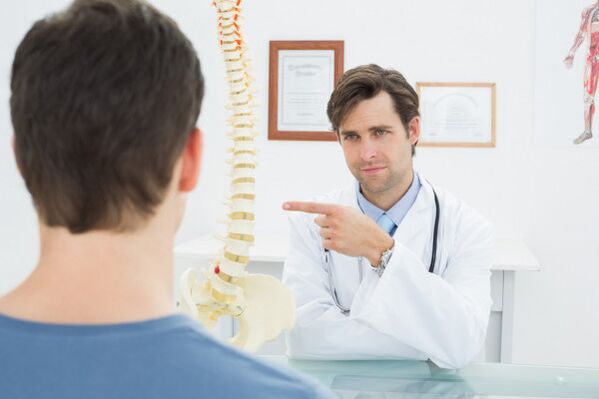Cervical osteochondrosis is a common form of the disease that affects the upper spine and causes specific symptoms at each stage of development. Most patients let the problem go on its own without asking a doctor for help.

Reasons for the development of osteochondrosis of the neck
Osteochondrosis of the cervical region of the second and third degrees causes degenerative-dystrophic changes in the tissues of the spine. First, the fibrinous ring is destroyed, then protrusion and herniation of the nucleus of the intervertebral disc occur. The pathology is accompanied by pain and dysfunction.
Causes that negatively affect the spine and the development of cervical osteochondrosis to varying degrees:
- physical inactivity (sedentary work, minimal physical activity);
- genetic predisposition to the disease;
- problems with the immune response;
- unbalanced diet, against the background of which there is a lack of minerals, trace elements or a certain group of vitamins;
- frequent hypothermia, a tendency to inflammatory processes;
- systematic errors in the work of the endocrine system;
- obesity at any stage;
- spinal injuries;
- Hard physical work.
Osteochondrosis of the neck region of the second and all subsequent degrees is considered the most severe. The reason is the narrow location of the nerves and blood vessels responsible for nourishing and innervating the brain.
More often the pathology occurs in people over 50 years old, cervical osteochondrosis of the 3rd degree is diagnosed.
What is and symptoms of osteochondrosis of the neck
Osteochondrosis is a dystrophic process that has a devastating effect on the bones and cartilage that make up the spine, on nearby soft tissues.
With the development of degenerative-destructive cervical pathology, the intervertebral discs lose their protective properties.
Gradual destruction, displacement of anatomical elements leads to negative consequences:
- Cartilage partially or completely loses its depreciation properties;
- disc deformation;
- Destruction of the fibrous ring (begins at the initial stage);
- the formation of osteophytes - bone growths on the surface of the vertebrae.
Each degree of cervical osteochondrosis is characterized by special manifestations. If at the initial stage (first and second stages) a person is bothered by minor ailments, then in an advanced form the disease causes a number of complications.

First Degree
Osteochondrosis of the 1st degree of the cervix can occur without any clinical manifestations. The main complaint of the patient is pain in the neck.
Massage helps relieve discomfort. On palpation, the patient feels stiffness of the muscles in the collar zone, strong or moderate tension. If you start treatment on time, you can stop the initial process of anomalies of osteochondrosis of the first and second degrees.
second degree
Symptoms of grade 2 cervical osteochondrosis are more pronounced. The phase of exacerbation is accompanied by severe discomfort. Immediate and complex treatment with injections is required.
Main manifestations:
- persistent headache;
- discomfort when moving the head;
- movement stiffness in the neck-collar area;
- during the period of exacerbation it is possible to stop the pain syndrome for a short time;
- Lethargy;
- sleep disturbance;
- increased fatigue;
- decrease in working capacity;
- posture suffers, a person cannot freely take a comfortable position;
- Dizziness.
Manifestations depend on which artery, vein, or nerve bundle was clamped. The muscles of the cervical collar zone and the face, ears, head can become numb. The person may be disabled.
third degree
The third degree is characterized by an active lesion of the fibrous ring.
Injury leads to the appearance of protrusions, herniated discs.
The progression of cervical disease is characterized by a pronounced pain syndrome, which cannot always be stopped with powerful analgesics. Neurological disorders gradually progress.
fourth degree
At the last stage, degenerative-destructive processes reach their peak. It is difficult for patients to move, stiffness reaches its maximum. Sometimes the pain can subside, but this is a dangerous sign. Between the vertebral elements, bone tissue begins to grow, which leads to even greater deterioration and deterioration in well-being.
stage diagnostics
Instability of the intervertebral discs, questions about eliminating the consequences of tissue destruction are examined by a neurologist. The doctor checks the neck reflexes with a hammer, tests of coordination.
Instrumental research:
- radiography;
- CT scan;
- magnetic resonance imaging;
- Ultrasound of the vertebral arteries.
X-rays are taken from the front and side.
MRI and CT are informative research methods. The only disadvantage is the high cost of the procedure.
Ultrasound is performed when it is necessary to determine the degree of damage to the vertebral arteries, to assess the condition of the cervical spine. The results will help form the prognosis of the disease.
Therapy of osteochondrosis of the neck region of the second degree
The basis of any therapeutic effect in osteochondrosis of the cervical spine is taking drugs that will help get rid of the manifestations of the disease. The treatment regimen is determined by several specialists - a therapist, a neurologist.
anesthesia of patients
Treatment of patients with second degree osteochondrosis of the neck begins with a complex of painkillers. The doctor selects analgesics based on their effectiveness and the presence of contraindications in the patient.
Fight against inflammatory foci
Anti-inflammatory drugs help eliminate foci of inflammation and reduce pain in patients with cervical osteochondrosis.
Nonsteroidal drugs have a negative consequence - they have an aggressive effect on the mucous membranes of the digestive tract.
Anti-inflammatory analgesics of the nonsteroidal group can be prescribed in tablets or injections, as with exacerbation of osteochondrosis in the second and third stages of development. Gels, ointments, creams are often used for external treatment.
chondroprotectors
In the schemes for the treatment of osteochondrosis of the neck of the second degree, the protectors of cartilage and bone tissue have a special role.
surgery
If therapy for cervical osteochondrosis of the second, and sometimes third degree, with drugs takes place at home, then radical treatment will require hospitalization of the patient. Indications for an operation:
- instability of the spine;
- spinal cord compression;
- hernia formation.
It is impossible to completely solve the problem of pathological destruction of the neck with the progression of osteochondrosis.
gymnastics and movement therapy
If it is not possible to fully restore the functional potential of the spine, then it is possible to stop the progression of the disease.
In the early stages (first and sometimes second degree of cervical osteochondrosis), simple folk methods and therapeutic exercises will help. Such leisure activities are not expensive, easy to carry out, do not cause pain, do not cause discomfort.
In the later stages of the development of neck osteochondrosis of the second or third degree, gymnastics and exercise therapy are recommended. The exercises are carried out under the supervision of a specialist. It's important to do everything right. The main goal: to strengthen the neck muscles and relax them at the same time.
It is important that the patient strives for recovery, carefully follows the recommendations of specialists and the prescriptions of doctors.
































